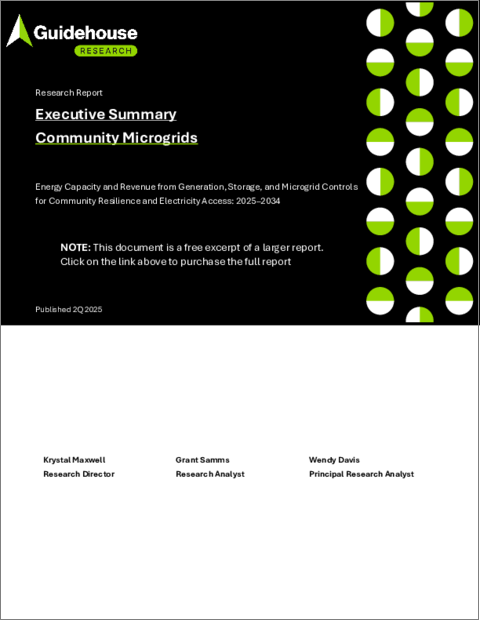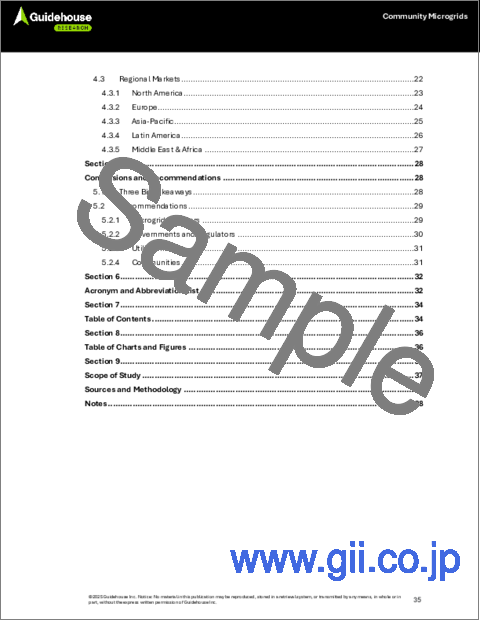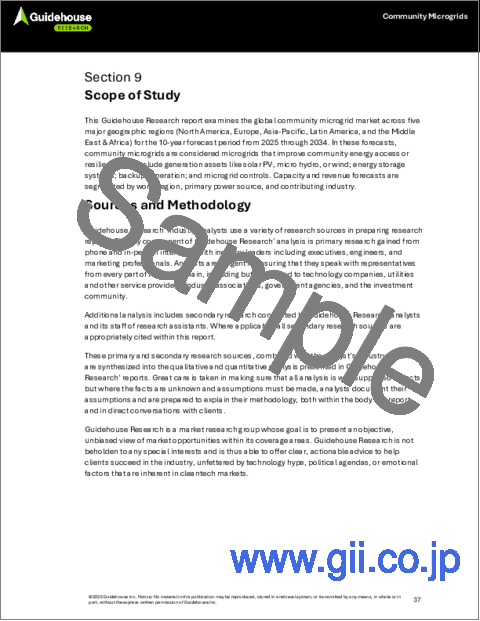|
|
市場調査レポート
商品コード
1748484
コミュニティマイクログリッドの世界市場Community Microgrids - Energy Capacity and Revenue from Generation, Storage, and Microgrid Controls for Community Resilience and Electricity Access, 2025-2034 |
||||||
|
|||||||
| コミュニティマイクログリッドの世界市場 |
|
出版日: 2025年06月13日
発行: Guidehouse Research
ページ情報: 英文 40 Pages
納期: 即納可能
|
全表示
- 概要
- 目次
遠隔地やその他の脆弱なコミュニティにとって、信頼できる電力へのアクセスは必ずしも経済的・物理的に現実的ではありません。コミュニティマイクログリッドは、このようなコミュニティにおけるエネルギーアクセスを向上させるための拡大しつつあるアプローチであり、多くの場合、送電線の強化やディーゼル発電所のような他の選択肢よりも低コストかつ低炭素です。コミュニティマイクログリッドは、発電、蓄電、制御、配電技術を組み合わせたもので、コミュニティのエネルギー信頼性を高めます。このようなマイクログリッドは、遠隔地のコミュニティを電化し、電力企業の負担を減らし、経済発展を可能にするために、先進地域でも発展途上地域でもますます利用されるようになっています。
コミュニティマイクログリッドの促進要因と障壁は、規制アプローチやインフラの状況が異なるため、地域によって異なります。現在、全体的な発電能力の成長において最大の促進要因となっているのは、北米で電力企業がマイクログリッドを採用していることで、これはインフラの老朽化や山火事の法的責任に直面する中で、全体的な財務リスクや法的リスクを軽減するためのものです。その他の促進要因としては、発展途上地域における農村の電化活動や、コミュニティのレジリエンス向上への取り組み、クリーンエネルギープログラムに対する政府の投資、重要なマイクログリッドコンポーネントのコスト低下などがあります。障壁としては、規制の明確性の欠如、貿易政策の逆風と関税構造、適切なレベルの資本へのアクセスが挙げられます。
当レポートでは、世界のコミュニティマイクログリッド市場について調査し、現在の課題、技術動向、促進要因と障壁、政策情勢などを分析しています。
目次
第1章 エグゼクティブサマリー
- 調査範囲
- 市場促進要因と障壁
- 市場予測
- イントロダクション
- 技術の説明
- 促進要因
- 電力企業の経営リスクとコスト
- 農村の電化
- 政府のプログラムと資金
- 悪天候、コミュニティのレジリエンスの必要性
- DERとマイクログリッドコンポーネントのコスト低下
- 障壁
- 貿易政策と関税
- 資本へのアクセス
- システムと規制の複雑性
- レジリエンスに対する市場価値の欠如
- 政策情勢
- 価格
第3章 産業バリューチェーン
- 競合情勢
- 合併と買収
- ビジネスモデルの進化
第4章 市場予測
- 調査手法と範囲
- 世界市場
- 地域市場
- 北米
- 欧州
- アジア太平洋
- ラテンアメリカ
- 中東・アフリカ
第5章 結論と提言
- 3つの大きなポイント
- 提言
- マイクログリッドプロバイダー
- 政府、規制当局
- 電力企業
- コミュニティ
第6章 頭字語と略語のリスト
第7章 目次
第8章 図表
第9章 調査範囲、情報源と調査手法、注記
For remote or otherwise vulnerable communities, access to reliable electricity is not always economical or physically practical. Community microgrids are a growing approach to improve energy access in these communities, often at a lower cost and carbon intensity than other options like line hardening or diesel powerhouses. Community microgrids are combinations of electricity generation, storage, control, and distribution technologies that raise energy reliability for communities. These microgrids are increasingly used in both developed and developing regions to electrify remote communities, lower utility liability, and enable economic development.
The drivers and barriers for community microgrids vary across regions owing to different regulatory approaches and infrastructure conditions. The largest driver today in overall capacity growth is utilities adopting microgrids in North America to reduce their overall financial and legal risks in the face of aging infrastructure and wildfire liability. Other drivers include rural electrification efforts in developing regions, community resilience initiatives, government investment in clean energy programs, and declining costs for critical microgrid components. Barriers include a lack of regulatory clarity, trade policy headwinds and tariff structures, and access to appropriate levels of capital.
This Guidehouse Research report examines the global market for community microgrids. The report analyzes current market issues, technology trends, drivers and barriers, and the policy landscape. Market forecasts are presented for capacity additions and revenue, and are segmented by world region, primary power source, and contributing industry. Forecasts cover the period from 2025 to 2034.
Table of Contents
1. Executive Summary
- 1.1 Report Scope
- 1.2 Market Drivers and Barriers
- 1.3 Market Forecasts
- 2.1 Introduction
- 2.1.1 Technology Descriptions
- 2.2 Drivers
- 2.2.1 Utility Operational Risks and Costs
- 2.2.2 Rural Electrification
- 2.2.3 Government Programs and Funding
- 2.2.4 Severe Weather and Community Resilience Needs
- 2.2.5 Cost Decreases for DER and Microgrid Components
- 2.3 Barriers
- 2.3.1 Trade Policy and Tariffs
- 2.3.2 Access to Capital
- 2.3.3 System and Regulatory Complexity
- 2.3.4 Lack of Market Value for Resilience
- 2.4 Policy Landscape
- 2.5 Pricing
3. Industry Value Chain
- 3.1 Competitive Landscape
- 3.1.1 Mergers and Acquisitions
- 3.1.2 Business Model Evolution
4. Market Forecast
- 4.1 Methodology and Scope
- 4.2 Global Market
- 4.3 Regional Markets
- 4.3.1 North America
- 4.3.2 Europe
- 4.3.3 Asia-Pacific
- 4.3.4 Latin America
- 4.3.5 Middle East & Africa
5. Conclusions and Recommendations
- 5.1 Three Big Takeaways
- 5.2 Recommendations
- 5.2.1 Microgrid Providers
- 5.2.2 Governments and Regulators
- 5.2.3 Utilities
- 5.2.4 Communities






